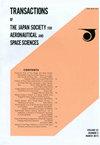Feasibility Study on Real-time Observation of Flow Velocity Field using Sparse Processing Particle Image Velocimetry
IF 0.8
4区 工程技术
Q4 ENGINEERING, AEROSPACE
Transactions of the Japan Society for Aeronautical and Space Sciences
Pub Date : 2021-01-01
DOI:10.2322/tjsass.64.242
引用次数: 17
Abstract
Active flow control such as the use of a plasma actuator has been gathering much attention. Its effectiveness in flow separation control has been investigated experimentally and numerically.1) However, the capability during highspeed airflow is limited due to the lack of the flow control effect. Hence, feedback control utilizing the real-time measurement of the flow state is expected to improve applicability.2) Because of the complexity and nonlinearity of the flow phenomena, feedback control based on not the local flow information, but the full-state or global flow information clearly appears to be better for the future feedback control of flows. The use of particle image velocimetry (PIV), which provides the instantaneous velocity field in laboratory measurement can be used for nearly full-state observation. Therefore, real-time PIV measurement of the flow field seems to be a powerful tool for flow control. The velocity field is calculated from the cross-correlation coefficient for each interrogation window of the particle images during the PIV measurement, but the number of windows that can be processed in a short duration is limited. This is because the PIV computational time is too long when real-time PIV measurement is applied to aerodynamic flow-control experiments, which have a shorter time scale than hydrodynamic experiments. In this study, reduced-order modeling is employed and reducing the calculation time is considered. The authors proposed sparse processing PIV (SPPIV) as a method to achieve the real-time nearly full-state estimation. The PIV measurement of the flow field around a NACA0015 airfoil model was conducted and the flow field obtained using SPPIV and the processing time were evaluated.稀疏处理粒子图像测速实时观测流场的可行性研究
主动流量控制,如等离子体致动器的使用,已经引起了人们的广泛关注。实验和数值研究了其在流动分离控制中的有效性。1)但由于缺乏流动控制效果,其在高速气流中的性能受到限制。因此,利用流态实时测量的反馈控制有望提高适用性。2)由于流动现象的复杂性和非线性,基于全状态或全局流动信息而不是局部流动信息的反馈控制显然更适合未来的流动反馈控制。利用粒子图像测速技术(PIV),提供了在实验室测量中可用于近全态观测的瞬时速度场。因此,流场的实时PIV测量似乎是流动控制的有力工具。在PIV测量过程中,速度场由粒子图像各询问窗口的互相关系数计算得到,但短时间内可处理的窗口数量有限。这是因为将实时PIV测量应用于气动流动控制实验时,PIV计算时间太长,而气动流动控制实验的时间尺度比水动力实验短。本研究采用了降阶建模,并考虑了减少计算时间。作者提出了稀疏处理PIV (SPPIV)作为一种实现实时近全状态估计的方法。对NACA0015翼型模型的流场进行了PIV测量,并对SPPIV得到的流场和处理时间进行了评估。
本文章由计算机程序翻译,如有差异,请以英文原文为准。
求助全文
约1分钟内获得全文
求助全文
来源期刊
CiteScore
1.80
自引率
0.00%
发文量
18
审稿时长
>12 weeks
期刊介绍:
Information not localized

 求助内容:
求助内容: 应助结果提醒方式:
应助结果提醒方式:


